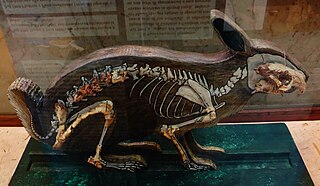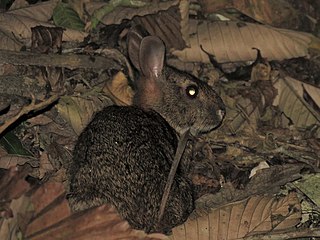
Rabbits, also known as bunnies or bunny rabbits, are small mammals in the family Leporidae, which is in the order Lagomorpha. Oryctolagus cuniculus is the European rabbit, including its descendants, the world's 305 breeds of domestic rabbit. Sylvilagus includes 13 wild rabbit species, among them the seven types of cottontail. The European rabbit, which has been introduced on every continent except Antarctica, is familiar throughout the world as a wild prey animal, a domesticated form of livestock and a pet. With its widespread effect on ecologies and cultures, in many areas of the world, the rabbit is a part of daily life – as food, clothing, a companion, and a source of artistic inspiration.

The lagomorphs are the members of the taxonomic order Lagomorpha, of which there are two living families: the Leporidae and the Ochotonidae (pikas). There are 110 recent species of lagomorph of which 109 are extant, including 10 genera of rabbits, 1 genus of hare and 1 genus of pika. The name of the order is derived from the Ancient Greek lagos + morphē.

Leporidae is the family of rabbits and hares, containing over 70 species of extant mammals in all. The Latin word Leporidae means "those that resemble lepus" (hare). Together with the pikas, the Leporidae constitute the mammalian order Lagomorpha. Leporidae differ from pikas in that they have short, furry tails and elongated ears and hind legs.

The desert cottontail, also known as Audubon's cottontail, is a New World cottontail rabbit, and a member of the family Leporidae. Unlike the European rabbit, they do not form social burrow systems, but compared with some other leporids, they are extremely tolerant of other individuals in their vicinity.

The eastern cottontail is a New World cottontail rabbit, a member of the family Leporidae. It is the most common rabbit species in North America.

The common tapeti, also known as the Brazilian cottontail, forest cottontail, or (formerly) simply tapeti is a species of cottontail rabbit. It is small to medium-sized with a small, dark tail, short hind feet, and short ears. As traditionally defined, its range extends from southern Mexico to northern Argentina, but this includes several distinctive population that have since been split into separate species. Under this narrower definition, the true tapeti only occurs in the Atlantic Rainforest of coastal northeastern Brazil and it is classified as "Endangered" by the IUCN. The American Society of Mammalogists concurs, but also tentatively classifies several distinct populations that have not yet received proper species names into S. brasiliensis, and thus considers it to range from Venezuela south to Argentina.

The Mexican cottontail is a species of cottontail rabbit in the family Leporidae. It is endemic to Mexico where its natural habitats are temperate forests, subtropical or tropical dry forests and pastureland.

Dice's cottontail is a species of cottontail rabbit in the family Leporidae. It is found in Costa Rica and Panama, in páramo and cloud forest habitats.

The Tres Marias cottontail or Tres Marias rabbit is a species of mammal in the family Leporidae.

The mountain cottontail or Nuttall's cottontail is a species of mammal in the family Leporidae. It is found in Canada and the United States.

The marsh rabbit is a small cottontail rabbit found in marshes and swamps of coastal regions of the Eastern and Southern United States. It is a strong swimmer and found only near regions of water. It is similar in appearance to the eastern cottontail but is characterized by smaller ears, legs, and tail.

The robust cottontail or Holzner's cottontail is a species of cottontail rabbit native to high-altitude regions of the southwestern United States and western Mexico.

Hypolagus is an extinct genus of lagomorph, first recorded in the Hemingfordian of North America. It entered Asia during the early Turolian and spread to Europe not much later, where it survived until the Middle Pleistocene. Though unknown in the Iberian Peninsula, fossils of this genus have been found in the Balearic Islands, suggesting an eastern migration during the dry period in the Mediterranean region known as the Messinian Salinity Crisis.

The Suriname tapeti or Suriname lowland forest cottontail is a South American species of cottontail rabbit described in 2017. It is known from the lowlands of western Suriname, and was described from specimens collected by Dutch scientists in the 1980s. Its size is relatively large for a South American cottontail rabbit. The rabbit is likely already threatened due to environmental degradation in the region, and its discovery could boost conservation efforts in the area. It was discovered by Portland State University Professor Luis Ruedas.

The coastal tapeti, also known as the Rio de Janeiro dwarf cottontail or dwarf tapeti, is a species of cottontail rabbit native to Brazil. Known from only three specimens, captured in the late nineteenth century in the Paraíba Valley, it was for a long time considered to be a subspecies of the common tapeti. Slightly smaller than its close relative, analysis in 2017 confirmed that it is sufficiently distinct in both appearance and genetics to be considered a species in its own right. Due to destruction of its putative habitat in the densely populated Paraíba Valley, it is unclear whether or not the species still survives in the present day.

The Andean tapeti or Andean cottontail is a species of cottontail rabbit native to Colombia, Venezuela, Peru and Ecuador. It was previously considered a subspecies of the common tapeti. Living at high elevations in the treeless Páramo of the Andes, analysis in 2017 confirmed that it is sufficiently distinct in both appearance and genetics to be considered a species in its own right. Although widespread, it remains poorly known, as few studies have been conducted on its biology and habits as distinct from those of the tapeti

The Central American tapeti or Gabbi's cottontail is a species of cottontail rabbit native to southern Mexico and much of Central America. It was previously considered a subspecies of the common tapeti but analysis in 2017 confirmed that it is sufficiently distinct in both appearance and genetics to be considered a species in its own right. The name Gabbi's cottontail comes from American paleontologist William More Gabb.




































